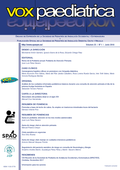![]()
Los obesos permanecen obesos. Evolución de la obesidad infanto-juvenil en un centro de salud durante 5 años
Introducción: En España existe un aumento de obesidad, hasta constituir un problema importantede salud pública. En Andalucía se inició en el 2007 el Plan Integral de Obesidad infantil(PIOBIN) para frenar esta enfermedad en los niños.
Objetivos: Analizar la evolución del índice de masa corporal (IMC) y de los datos de las consultasatendidas de los niños incluidos en dicho programa y en los 5 años posteriorestanto en las consultas pediátricas como de medicina de familia.
Material y método: Ámbito: Población registrada en PIOBIN en el CS Amante Laffón de Sevilla. Temporalización:inclusión en PIOBIN desde el 01/01/2009 al 31/12/2013 y revisión de visitasdesde el 2013 al 2018.
Intervención: Revisión de historias clínicas de los usuariosregistrados en PIOBIN y en los 5 años sucesivos. Se analiza el IMC y su evolución,sexo, edad y el número de visitas realizadas en estos últimos 5 años.Resultados: Se han incluido 126 usuarios, 52 niños (40,94%) y 74 niñas (58,73%) con una edadmedia de 17,22 años. 61 de ellos (48,03%) no han realizado ninguna consulta decontrol, 28 niños y 33 niñas. Acuden al menos una vez en los últimos 5 años 65 pacientes,de los cuales 41 son mujeres (63,07%) y 24 varones con 1.3 visitas de media.El IMC aumenta en 52 personas (80% del total de los que realizan seguimiento),disminuye en 11 (16,92% del total) y se mantienen sin cambios en 2 niñas (3,07%).
Conclusiones: En casi la mitad (48,3%) de los usuarios incluidos en el programa cuando pasana la consulta de medicina de familia, no aparece anotado ningún registro de IMC.Consideramos importante la continuidad en la prevención y el tratamiento de la obesidad,aunque existe escasa concienciación de la importancia de ésta.Los esfuerzos realizados no parecen suficientes para el control de la obesidad.
Introduction: In recent years, obesity has become an important public health problem in Spain.The PIOBIN program (Childhood Obesity Integral Plan) was launched in Andalusia in2007 to try to stop this disease during childhood.
Objectives: The main purpose of this study is to analyse the BMI evolution and the successivefollow-up visits of the children included in this program 5 years after completion, bothin pediatric and general medical consultations.
Material and methods: Scope: Users registered in the PIOBIN program in the Amante Laffón Health Centre (Seville).Temporalisation: Patients included in the PIOBIN program between 01/01/2009-31/12/2013; review of the medical examinations made between 2013 to 2018.
Intervention:Review of the medical history of the patients included in the PIOBIN program.We analysed BMI, BMI evolution, sex, age and the number of medical examinationsperformed between 2013 and 2018.Results: 126 patients were included in this study, 52 males (40,94%) and 74 females (58,73%).Average age was 17,22 years. 61 patients (48,03%) did not have any follow-up visitduring the time of the study, 28 males, 33 females. 65 patients had at least one follow-up visit, 41 females (63.07%) and 24 males. Average number of follow-up visitswas 1,3. 52 patients (80%) showed an increased BMI. This parameter decreased in 11patients (16.92%) and remain unchanged in 2 patients (3.07%).
Conclusions: About half of the patients (48.3%) included in this study did not have any follow upvisit with BMI control after they reached adult age. We consider that the continuity inthe transition from paediatric to adult care is key in order to prevent and treat obesitycorrectly. However, there is little awareness of its importance. Current practices andprotocols do not seem to be sufficient to control obesity.
| Adjunto | Tamaño |
|---|---|
| 37-vox_n26-2.pdf | 127.74 KB |



